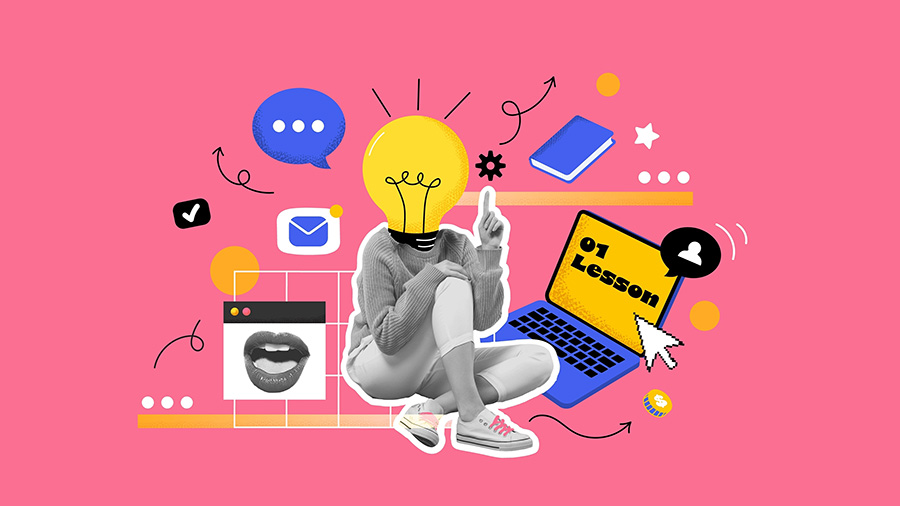Have you ever wondered how to make your classes more dynamic, use a variety of technologies, and apply new teaching methods but don’t know how to go about it? And do your internet searches produce so much information that you find it impossible to come up with an idea?
Tec de Monterrey’s Department of Educational Innovation and Digital Learning puts the Teaching Hub portal at its professors’ disposal, offering them a variety of collections, design guidelines, and resources to help make their courses more innovative.
“The goal is to make validated or approved tools available to our professors in a very practical, easy-to-use environment.
“These guidelines are very practical and easy to follow. Teachers have access to the most recent developments and use them to innovate in their classes by coming up with new teaching methods or course content,” said Maribell Reyes, director of Digital Education at the Tec.

Myriam Villareal, Director of Pedagogical Design and Architecture, recalled that regardless of whether it is for architecture, design, communication, engineering, or some other kind of course, the resources indicate if some type of technology is required.
“Different types of technology, which must form part of the academic software portfolio previously authorized by the Tec, are recommended for each of the strategies, methods, or practices.
“These collections come with teaching and course design considerations and much more. The idea is that it should be a one-stop shop where teachers have access to all the information they need for implementation purposes.”
It should be noted that the content is organized into collections, each of which gives real-world examples of how teachers have implemented different strategies to enrich their courses.
These are Teaching Hub’s available resources
This Tec tool enables professors to design courses at all levels: high school, undergraduate, and postgraduate. A variety of strategies and resources are available in the Teaching Hub and are organized into specialized collections to make them easier to browse and select topics of interest.
“A variety of collections are available. The advantage is that professors can sign in at any time and access comprehensive, in-depth, step-by-step information on how to design their training units.
“This space is open to everyone in the Tec. We have amassed highly focused documents providing teachers with the tools and resources to be able to design training units at different levels,” explained Yolanda Dominguez, Director of Digital Experience Design and Development.
Here you will find a collection of evaluation strategies approved by education specialists and teachers.
Filters can be used to search strategies for topics of interest according to your needs, and recommendations are made and examples given of how to apply the strategies.
Recommendations are also made to provide effective feedback on evaluation processes.

2.- Innovative teaching strategies
Teaching Hub has a space reserved for teaching strategies designed to create innovative educational experiences. These strategies are grouped according to ten specific goals.
Categories include the enhancement of critical thinking, experiential and social learning, and topics such as integral education and learning flexibility.
The purpose, characteristics, advantages and limitations of each strategy are specified and examples, relevant articles, and related research are provided along with other data that will be useful for its application.
Furthermore, didactic strategies are classified into three types: learning, teaching, and evaluation, which must be interrelated to achieve the desired learning outcomes.
3.- Tec Virtual Campus experience
This type of virtual environment makes it possible to call on real-world social interactions to maintain a sense of community that other tools cannot replicate.
Distance is not a factor when getting involved in Tec Virtual Campus activities. Moreover, as you become immersed in a collection of activities based on topics of interest designed to meet your needs, recommendations are made and examples given.
“The goal is to provide our professors with validated tools or resources of practical value.” - Maribell Reyes
4.- Good practices for digital classes
This offers a collection of strategies designed to make classes more dynamic and interactive in an effort to encourage student participation and make the role of the teacher more impactful.
Strategies are organized into categories according to different educational purposes.
Some focus on providing tools and skills for lesson design and teaching while others focus on practical classroom applications.
5.- Evaluation instruments
In this collection, you will find a variety of evaluation instruments approved by education specialists in collaboration with teaching colleagues.
You will also find topics of interest to help filter the content according to professors’ needs, examples and recommendations.
6.- Fun activities
As its name suggests, this section contains fun classroom activities.
Fun activities are strategies that involve playing games with an educational purpose that encourage students to learn and develop skills actively.
This section provides activities based on topics of interest that will help filter the content according to the needs of the course and the professors.

7.- Strategies for educational use and generative AI tools
Maribell Reyes emphasized that this is a resource for teachers interested in exploring the use of generative AI tools in the teaching-learning process, taking care of the development and application of critical thinking while using technology ethically and responsibly.
In this space, you will find a collection that includes strategies and activities employing generative artificial intelligence to create inspiring educational experiences.
Resources may be tailored to both professors’ and students’ needs.
8.- Content resources
Content resources are teaching materials that have been developed based on knowledge and practice.
Here you will find teaching resources designed and ready for classroom use; this optimizes the time spent planning and designing the course or training unit.
9.- Professor participation beyond the classroom
In this collection, you will discover strategies for becoming more socially involved beyond any direct interaction that may take place in face-to-face or distance sessions in a training unit.
Cohesive, affective, and interactive strategies are some of the ways professors are encouraged to get involved socially.

10.- Accessibility and inclusion tools
Tec de Monterrey seeks to ensure an educational work environment that promotes respect for human dignity, non-discrimination, and a sense of belonging.
That being the case, this section contains strategies for raising awareness and tools that provide ideas, examples and resources to enhance our teaching in an environment where diversity takes pride of place for the benefit of human development.
11.- Pre-designed lesson plans
Here you will find sample lesson plans with well-structured teaching sequences that may be useful as a source of inspiration or a starting point to design your own class.
Plans contain suggestions for use, content descriptions, and other useful information.
12.- Affective-cognitive strategies
The strategies in this section enable you to foster safe and participatory emotional learning environments and enrich your teaching practice with activities that enhance student motivation.
These strategies have been designed by specialists in education and come with recommendations on how to put them into practice, theoretical principles, and any materials, apps or technology that may be required.
13.- Digital learning experiences
A digital learning experience is the result of technology-mediated activities that help learners develop and strengthen competencies.
This can be used for different purposes and may enrich some of your teaching objectives.
It should be noted that any use in training units must be intentional, systematic, and planned and may occur in any environment or context.
Teaching Hub offers a catalog of examples and resources for the inclusion of digital learning experiences in your courses.
“Oftentimes we don’t pluck up the courage to do something different because we don’t know where to start. Teaching Hub is a source of inspiration.” - Laura Zepeda
Four steps to create your course
If you don’t know how to get started designing a course, Teaching Hub also explains the four steps you can follow:
- Plan your course: This will help you with the groundwork by explaining how to consult the course breakdown, defining teaching processes, reviewing learning and competency objectives, and tailoring course content, among other things.
- Produce course content: This space will enable you to design your course in Canvas based on the learning map you created in the first step.
- Lay out the course in Canvas: Here, you will find out how to do a variety of basic course set-ups, which will help students obtain a more fruitful learning experience.
- Final review: Course quality is important. This step explains the resources you can take advantage of to ensure design quality and guarantee a successful experience.
“Oftentimes as teachers we don’t pluck up the courage to do something different because with so much information available, we don’t know where to start. Teaching Hub is a source of inspiration,” said Laura Zepeda, Pedagogical Model Innovation leader.
Yolanda Domínguez, Director of Digital Experience Design and Development, explained how one of Teaching Hub’s advantages is that teachers can sign in at any time to be given far-reaching, clear, structured, in-depth information concerning the design of their training units in four simple steps including practical recommendations and downloadable formats that facilitate and guide each step of the process.
“Moreover, it’s something you can take ownership of and give it a personal touch. Teachers can tailor, adapt, and mix it up according to their teaching practice,” said Laura Zepeda in conclusion.
ALSO READ:





